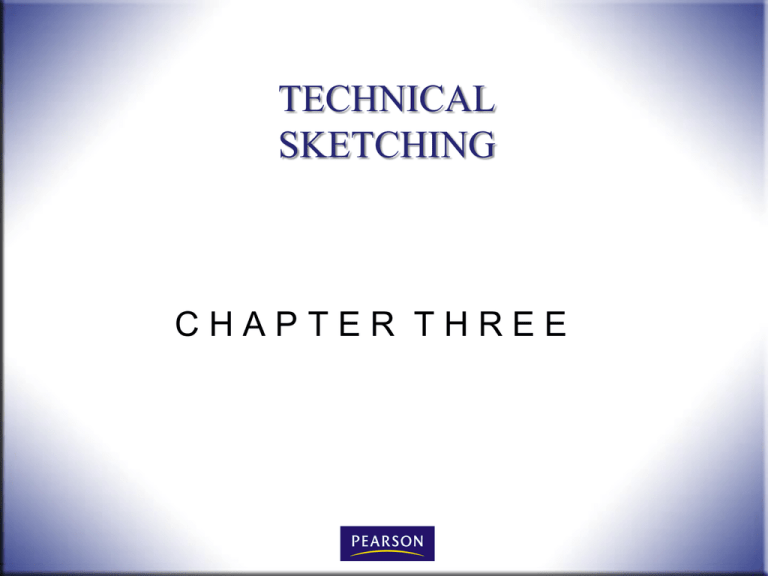
TECHNICAL
SKETCHING
CHAPTER THREE
OBJECTIVES
After studying the material in this chapter, you should be able to:
1. Define the terms vertex, edge, plane, surface, and solid.
2. Identify four types of surfaces.
3. Identify five regular solids.
4. Draw points, lines, angled lines, arcs, circles, and ellipses.
5. Apply techniques that aid in creating legible well-proportioned
freehand sketches.
6. Apply techniques to draw irregular curves.
7. Create a single-view sketch.
8. Create an oblique sketch.
9. Create perspective sketches.
10. Create an isometric sketch of an object.
Shaded Sketch Showing Details of Wire
Placement. (Courtesy of Quantum Design.)
Technical Drawing with Engineering Graphics, 14/e
Giesecke, Hill, Spencer, Dygdon, Novak, Lockhart, Goodman
2
© 2012, 2009, 2003, Pearson Higher Education,
Upper Saddle River, NJ 07458. • All Rights Reserved.
UNDERSTANDING SOLID OBJECTS
Three-dimensional figures are referred
to as solids. Solids are bounded by
the surfaces that contain them. These
surfaces can be one of the following four
types:
• Planar
• Single curved
• Double curved
• Warped
Regardless of how complex a solid
may be, it is composed of combinations
of these basic types of surfaces.
Technical Drawing with Engineering Graphics, 14/e
Giesecke, Hill, Spencer, Dygdon, Novak, Lockhart, Goodman
3
© 2012, 2009, 2003, Pearson Higher Education,
Upper Saddle River, NJ 07458. • All Rights Reserved.
Types of Solids
If the faces of a solid are equal regular polygons, it is called a regular polyhedron.
Technical Drawing with Engineering Graphics, 14/e
Giesecke, Hill, Spencer, Dygdon, Novak, Lockhart, Goodman
4
© 2012, 2009, 2003, Pearson Higher Education,
Upper Saddle River, NJ 07458. • All Rights Reserved.
Prisms
A prism has two bases,
which are parallel equal
polygons, and three or
more additional faces,
which are parallelograms
Technical Drawing with Engineering Graphics, 14/e
Giesecke, Hill, Spencer, Dygdon, Novak, Lockhart, Goodman
5
© 2012, 2009, 2003, Pearson Higher Education,
Upper Saddle River, NJ 07458. • All Rights Reserved.
Pyramids
A pyramid has a polygon for a base and triangular lateral
faces that intersect at a common point called the vertex.
Technical Drawing with Engineering Graphics, 14/e
Giesecke, Hill, Spencer, Dygdon, Novak, Lockhart, Goodman
6
© 2012, 2009, 2003, Pearson Higher Education,
Upper Saddle River, NJ 07458. • All Rights Reserved.
Cylinders & Cones
A cylinder has a singlecurved exterior surface
A cone has a singlecurved exterior
surface
Technical Drawing with Engineering Graphics, 14/e
Giesecke, Hill, Spencer, Dygdon, Novak, Lockhart, Goodman
7
© 2012, 2009, 2003, Pearson Higher Education,
Upper Saddle River, NJ 07458. • All Rights Reserved.
Spheres, Tori & Ellipsoids
A sphere has a doublecurved exterior surface
A torus is shaped like
a doughnut
An oblate or prolate
ellipsoid is shaped like an
egg
Technical Drawing with Engineering Graphics, 14/e
Giesecke, Hill, Spencer, Dygdon, Novak, Lockhart, Goodman
8
© 2012, 2009, 2003, Pearson Higher Education,
Upper Saddle River, NJ 07458. • All Rights Reserved.
UNDERSTANDING SKETCHING
TECHNIQUES
Look for the essential shapes of objects
And use construction lines
break down
complex
shapes into
simpler
geometric
primitives
Technical Drawing with Engineering Graphics, 14/e
Giesecke, Hill, Spencer, Dygdon, Novak, Lockhart, Goodman
9
© 2012, 2009, 2003, Pearson Higher Education,
Upper Saddle River, NJ 07458. • All Rights Reserved.
SKETCHING
TECHNIQUES
The contours of an object are the main outlines that separate it from the
surrounding space. One way to think about the contours of objects is to look at
the contrast between the positive and negative space. Positive space is the
space occupied by the object. Negative space is the unoccupied space around it.
Technical Drawing with Engineering Graphics, 14/e
Giesecke, Hill, Spencer, Dygdon, Novak, Lockhart, Goodman
10
© 2012, 2009, 2003, Pearson Higher Education,
Upper Saddle River, NJ 07458. • All Rights Reserved.
Viewpoint and Shading
As you sketch objects, keep in mind that you want to
maintain a consistent viewpoint, like a camera does.
Adding shading to your sketch can give it a more
realistic appearance because it represents the
way the actual object would reflect
light.
Hatching and stippling
Technical Drawing with Engineering Graphics, 14/e
Giesecke, Hill, Spencer, Dygdon, Novak, Lockhart, Goodman
11
© 2012, 2009, 2003, Pearson Higher Education,
Upper Saddle River, NJ 07458. • All Rights Reserved.
Edges and Vertices
Edges
An edge of the solid is formed where two
surfaces intersect. Edges are represented in
drawings by visible or hidden lines.
Vertices
A vertex (plural, vertices) of a solid is
formed where three or more surfaces
intersect..
Points and Lines
A point is used to represent a location in space
but has no width, height, or depth.
Technical Drawing with Engineering Graphics, 14/e
Giesecke, Hill, Spencer, Dygdon, Novak, Lockhart, Goodman
12
© 2012, 2009, 2003, Pearson Higher Education,
Upper Saddle River, NJ 07458. • All Rights Reserved.
Points and Lines
A point is used to represent a location
in space but has no width, height, or
depth.
A line is used in drawings to represent the edge of a solid
object.
Technical Drawing with Engineering Graphics, 14/e
Giesecke, Hill, Spencer, Dygdon, Novak, Lockhart, Goodman
13
© 2012, 2009, 2003, Pearson Higher Education,
Upper Saddle River, NJ 07458. • All Rights Reserved.
Angles
An angle is formed by two intersecting lines. A common symbol
for angle is
.
Showing Angles
Technical Drawing with Engineering Graphics, 14/e
Giesecke, Hill, Spencer, Dygdon, Novak, Lockhart, Goodman
14
© 2012, 2009, 2003, Pearson Higher Education,
Upper Saddle River, NJ 07458. • All Rights Reserved.
Drawings and Sketches
The following are important skills to keep in mind for sketches
and drawings:
1. Accuracy. No drawing is useful unless it shows the information
correctly.
2. Speed. Time is money in industry. Work smarter and learn
to use techniques to speed up your sketching and CAD
drawings while still producing neat accurate results.
3. Legibility. A drawing is a means of communicating with
others, so it must be clear and legible. Give attention to details.
Things that may seem picky and small as you are
drawing may be significant and save money or even lives
when the product is built.
4. Neatness. If a drawing is to be accurate and legible, it must
also be clean.
Technical Drawing with Engineering Graphics, 14/e
Giesecke, Hill, Spencer, Dygdon, Novak, Lockhart, Goodman
15
© 2012, 2009, 2003, Pearson Higher Education,
Upper Saddle River, NJ 07458. • All Rights Reserved.
Freehand Sketching
Freehand sketches are a helpful way to organize your thoughts
and record ideas. They provide a quick, low-cost way to explore
various solutions to design problems so that the best choices can
be made.
Technical Drawing with Engineering Graphics, 14/e
Giesecke, Hill, Spencer, Dygdon, Novak, Lockhart, Goodman
16
© 2012, 2009, 2003, Pearson Higher Education,
Upper Saddle River, NJ 07458. • All Rights Reserved.
TECHNIQUE OF LINES
The chief difference between a drawing and a freehand sketch lies in the character
or technique of the lines.
A good freehand line is not
expected to be as rigidly straight
or exactly uniform. A good
freehand line shows freedom and
variety, whereas a line drawn
using CAD or instruments should
be exact.
line patterns
Technical Drawing with Engineering Graphics, 14/e
Giesecke, Hill, Spencer, Dygdon, Novak, Lockhart, Goodman
17
© 2012, 2009, 2003, Pearson Higher Education,
Upper Saddle River, NJ 07458. • All Rights Reserved.
Good and Poor Technique
Technical Drawing with Engineering Graphics, 14/e
Giesecke, Hill, Spencer, Dygdon, Novak, Lockhart, Goodman
18
© 2012, 2009, 2003, Pearson Higher Education,
Upper Saddle River, NJ 07458. • All Rights Reserved.
Lineweights
Even in freehand drawings, thick lines should be twice the width of thin lines.
Thicknesses do not have to be exact, but there should be an obvious
difference between thick and thin lines. Because visible lines and cuttingplane lines are the two thick line patterns, other lines should be distinctly
thinner in comparison.
To draw thick and thin lines freehand,
you might like to keep two pencils
handy, one that is razor sharp for thin
lines and another that is dulled, to
create thicker lines. As the sharp point
becomes dulled, switch it with the
dull pencil, and sharpen the other,
so that there is always one sharp
and one dulled point ready to use.
Technical Drawing with Engineering Graphics, 14/e
Giesecke, Hill, Spencer, Dygdon, Novak, Lockhart, Goodman
19
© 2012, 2009, 2003, Pearson Higher Education,
Upper Saddle River, NJ 07458. • All Rights Reserved.
SKETCHING STRAIGHT LINES
Most of the lines in an average sketch are straight lines. With
practice, your straight lines will naturally improve, but these
basics may help you improve quickly.
• Hold your pencil naturally, about 1" back from the point,
and approximately at a right angle to the line to be drawn.
• Draw horizontal lines from left to right with a free and
easy wrist and arm movement.
• Draw vertical lines downward with finger and wrist
movements.
Technical Drawing with Engineering Graphics, 14/e
Giesecke, Hill, Spencer, Dygdon, Novak, Lockhart, Goodman
20
© 2012, 2009, 2003, Pearson Higher Education,
Upper Saddle River, NJ 07458. • All Rights Reserved.
STRAIGHT LINE Tips
Technical Drawing with Engineering Graphics, 14/e
Giesecke, Hill, Spencer, Dygdon, Novak, Lockhart, Goodman
21
© 2012, 2009, 2003, Pearson Higher Education,
Upper Saddle River, NJ 07458. • All Rights Reserved.
STRAIGHT LINE Tips continued…
Technical Drawing with Engineering Graphics, 14/e
Giesecke, Hill, Spencer, Dygdon, Novak, Lockhart, Goodman
22
© 2012, 2009, 2003, Pearson Higher Education,
Upper Saddle River, NJ 07458. • All Rights Reserved.
STRAIGHT LINE Tips continued…
Technical Drawing with Engineering Graphics, 14/e
Giesecke, Hill, Spencer, Dygdon, Novak, Lockhart, Goodman
23
© 2012, 2009, 2003, Pearson Higher Education,
Upper Saddle River, NJ 07458. • All Rights Reserved.
STRAIGHT LINE Tips continued…
Technical Drawing with Engineering Graphics, 14/e
Giesecke, Hill, Spencer, Dygdon, Novak, Lockhart, Goodman
24
© 2012, 2009, 2003, Pearson Higher Education,
Upper Saddle River, NJ 07458. • All Rights Reserved.
STRAIGHT LINE Tips continued…
Technical Drawing with Engineering Graphics, 14/e
Giesecke, Hill, Spencer, Dygdon, Novak, Lockhart, Goodman
25
© 2012, 2009, 2003, Pearson Higher Education,
Upper Saddle River, NJ 07458. • All Rights Reserved.
METHODS FOR
SKETCHING CIRCLES
Technical Drawing with Engineering Graphics, 14/e
Giesecke, Hill, Spencer, Dygdon, Novak, Lockhart, Goodman
26
© 2012, 2009, 2003, Pearson Higher Education,
Upper Saddle River, NJ 07458. • All Rights Reserved.
METHODS FOR SKETCHING ARCS
Technical Drawing with Engineering Graphics, 14/e
Giesecke, Hill, Spencer, Dygdon, Novak, Lockhart, Goodman
27
© 2012, 2009, 2003, Pearson Higher Education,
Upper Saddle River, NJ 07458. • All Rights Reserved.
METHODS FOR SKETCHING ELLIPSES
Technical Drawing with Engineering Graphics, 14/e
Giesecke, Hill, Spencer, Dygdon, Novak, Lockhart, Goodman
28
© 2012, 2009, 2003, Pearson Higher Education,
Upper Saddle River, NJ 07458. • All Rights Reserved.
MAINTAINING PROPORTIONS
The most important rule in freehand sketching is to keep the sketch in
proportion, which means to accurately represent the size and
position of each part in relation to the whole.
To maintain proportions, first determine the relative
proportions of height to width and lightly block them in.
You can mark a unit on the edge of a strip of paper or
use your pencil to gauge how many units wide and
high the object is.
Technical Drawing with Engineering Graphics, 14/e
Giesecke, Hill, Spencer, Dygdon, Novak, Lockhart, Goodman
29
© 2012, 2009, 2003, Pearson Higher Education,
Upper Saddle River, NJ 07458. • All Rights Reserved.
ONE-VIEW DRAWINGS
Frequently, a single view supplemented by notes and dimensions
is enough information to describe the shape of a relatively
simple object.
Note how thickness of the material is given as “0.25 BRASS” So, an additional
view is not needed to dimensionally give the material thickness.
Technical Drawing with Engineering Graphics, 14/e
Giesecke, Hill, Spencer, Dygdon, Novak, Lockhart, Goodman
30
© 2012, 2009, 2003, Pearson Higher Education,
Upper Saddle River, NJ 07458. • All Rights Reserved.
PICTORIAL SKETCHING
A pictorial sketch represents a 3D object on a 2D sheet of paper
by orienting the object so you can see its width, height, and depth in a
single view.
Technical Drawing with Engineering Graphics, 14/e
Giesecke, Hill, Spencer, Dygdon, Novak, Lockhart, Goodman
31
© 2012, 2009, 2003, Pearson Higher Education,
Upper Saddle River, NJ 07458. • All Rights Reserved.
AXONOMETRIC
DRAWINGS
Various types of pictorial
drawings are used
extensively in catalogs,
sales literature, and
technical work. They are
often used in patent
drawings; in piping
diagrams; in machine,
structural, architectural
design, and in furniture
design; and for ideation
sketching.
Axonometric
(Courtesy of Douglas Wintin.)
Technical Drawing with Engineering Graphics, 14/e
Giesecke, Hill, Spencer, Dygdon, Novak, Lockhart, Goodman
32
© 2012, 2009, 2003, Pearson Higher Education,
Upper Saddle River, NJ 07458. • All Rights Reserved.
Projection Methods
The four
principal
types of
projections:
a Multiview
b Axonometric
c Oblique
d Perspective
Technical Drawing with Engineering Graphics, 14/e
Giesecke, Hill, Spencer, Dygdon, Novak, Lockhart, Goodman
33
© 2012, 2009, 2003, Pearson Higher Education,
Upper Saddle River, NJ 07458. • All Rights Reserved.
ISOMETRIC DRAWINGS steps…
Technical Drawing with Engineering Graphics, 14/e
Giesecke, Hill, Spencer, Dygdon, Novak, Lockhart, Goodman
34
© 2012, 2009, 2003, Pearson Higher Education,
Upper Saddle River, NJ 07458. • All Rights Reserved.
OBLIQUE SKETCHING steps…
Technical Drawing with Engineering Graphics, 14/e
Giesecke, Hill, Spencer, Dygdon, Novak, Lockhart, Goodman
35
© 2012, 2009, 2003, Pearson Higher Education,
Upper Saddle River, NJ 07458. • All Rights Reserved.
PERSPECTIVE DRAWING One-Point
steps…
Technical Drawing with Engineering Graphics, 14/e
Giesecke, Hill, Spencer, Dygdon, Novak, Lockhart, Goodman
36
© 2012, 2009, 2003, Pearson Higher Education,
Upper Saddle River, NJ 07458. • All Rights Reserved.
PERSPECTIVE DRAWING Two-Point
steps…
Technical Drawing with Engineering Graphics, 14/e
Giesecke, Hill, Spencer, Dygdon, Novak, Lockhart, Goodman
37
© 2012, 2009, 2003, Pearson Higher Education,
Upper Saddle River, NJ 07458. • All Rights Reserved.
SHADING
Shading can make it easier to visualize pictorial drawings, such as display
drawings, patent drawings, and catalog drawings.
Ordinary multiview and
assembly drawings are
not shaded.
Methods of Shading
Technical Drawing with Engineering Graphics, 14/e
Giesecke, Hill, Spencer, Dygdon, Novak, Lockhart, Goodman
38
© 2012, 2009, 2003, Pearson Higher Education,
Upper Saddle River, NJ 07458. • All Rights Reserved.
COMPUTER GRAPHICS
Pictorial drawings of all types can be created using 3D CAD
Shaded Dimetric Pictorial
View from a 3D Model.
(Courtesy of Robert Kincaid.)
Isometric Assembly Drawing. (Courtesy of Robert Kincaid.)
Technical Drawing with Engineering Graphics, 14/e
Giesecke, Hill, Spencer, Dygdon, Novak, Lockhart, Goodman
39
© 2012, 2009, 2003, Pearson Higher Education,
Upper Saddle River, NJ 07458. • All Rights Reserved.












